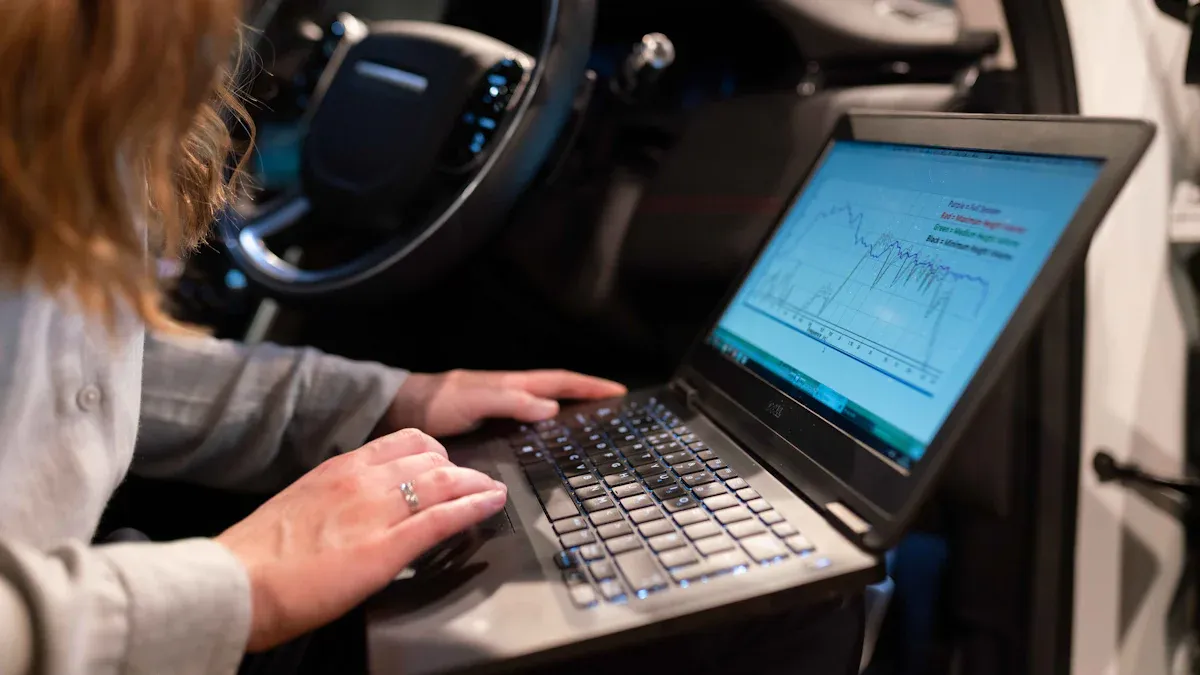Micromarket Shrinkage Rates: Is Self-Scanning Riskier Than Staffed Checkout?

Self-scanning causes more shrinkage in micromarkets than staffed checkout. The industry data shows this difference:
Checkout Type | Partial Shrink Rate (%) | |
|---|---|---|
Self-Checkout | 3.5 | 7 |
Traditional Cashier | 0.21 | 0.32 |
Micromarket shrinkage rates hurt profits. Operators have problems like theft from open layouts. They also deal with mistakes like under-ringing. They need to watch stores from far away. Security cameras and live monitors help lower these risks. Changing prices can also help.
Key Takeaways
Self-scanning causes more shrinkage. This means operators lose more money. Staffed checkouts can help lower these risks.
People make mistakes at self-checkout. Sometimes, they forget to scan items. Staff should help customers to stop errors.
Technology like AI cameras and smart shelves helps a lot. These tools can lower shrinkage rates. Stores should use them to keep profits safe.
Store layout is important. Good design lets staff watch products better. This helps stop theft.
Employees need regular training. Trained staff can see theft and mistakes. This leads to less shrinkage.
Key Findings on Micromarket Shrinkage Rates

Shrinkage Rate Data: Self-Scanning vs Staffed
Micromarket shrinkage rates are not the same for both checkout types. Operators lose more money when customers scan their own items. The table below shows the numbers for each checkout method:
Checkout Type | Shrink Rate (%) | Partial Shrink Rate (%) |
|---|---|---|
Self-Checkout | 6.7 | |
Staffed Checkout | 0.21 | 0.32 |
Self-checkout systems make it easier for mistakes to happen. Items can be missed or scanned wrong. Staffed checkout helps stop these problems because workers watch every sale. When people use self-scanning, shrinkage rates go up. This hurts profits and makes it harder to keep track of products.
Transaction Loss Comparison
Operators see different kinds of losses in micromarkets. Self-scanning leads to more errors, like missing scans or wrong items. Staffed checkout helps stop these mistakes because workers follow rules. The difference in shrinkage rates means operators must pick between making things easy or keeping control.
Self-scanning leads to higher shrinkage rates.
Staffed checkout keeps losses down.
Mistakes and theft happen more with self-scanning.
Micromarket shrinkage rates are important for every operator. More losses mean less money and more work to count products.
Industry Examples and Trends
Industry trends show that shrinkage rates change over time. Smart micromarkets use technology to lower losses. The table below shows how shrinkage rates are different for traditional and smart micromarkets:
Type of Market | Shrinkage Rate (%) | Reduction Compared to Traditional (%) |
|---|---|---|
Traditional Unmanned | 3-8 | N/A |
Smart Micromarkets | 70-85 |
Operators who watch their stores closely can lower shrinkage from 10% to 2-4% of revenue. Smart micromarkets use cameras and sensors to check transactions. These tools help stop mistakes and theft. Many operators now buy new technology to keep shrinkage rates low.
Note: Smart micromarkets have much lower shrinkage rates than older unmanned stores. Technology and watching stores closely help a lot.
Micromarket shrinkage rates keep changing as new ideas come out. Operators who follow trends and use better tools lose less money and make more profit.
Causes of Shrinkage Differences
Accidental Errors in Self-Scanning
Self-scanning systems can cause many mistakes. Customers sometimes forget to scan items. They might enter the wrong barcode. These mistakes make shrinkage rates go up. Most people do not mean to steal. They just make errors at self-checkout kiosks. Some shoppers hurry and miss items. Others do not know how to use the scanner. These problems happen often and cost operators money.
Theft and Fraud Risks
Micromarkets have theft and fraud risks, especially with self-scanning. More stores now use self-checkout. Self-checkout is 74% more common in the last two years. Traditional self-checkouts are easier to steal from than staffed lanes. People use tricks like:
The Banana Trick: Scanning a cheap item’s barcode for something expensive.
The Pass-Around: Skipping scans while distracting the worker.
The Switcheroo: Swapping barcodes between cheap and expensive items.
Studies show theft goes up by 65% at self-checkout. Staffed lanes have less theft. About 15% of people say they have stolen at self-checkout. Vision AI-powered systems can spot theft right away. These systems help lower theft. Operators can block barcode tricks, watch risky items, and check bags for big purchases.
Evidence Type | Description |
|---|---|
Self-checkout adoption increase | More stores use self-checkout, up 74% in two years. |
Vulnerability of traditional checkouts | Traditional self-checkouts are easier to steal from than staffed checkouts. |
AI-powered security benefits | Vision AI-powered self-checkouts can spot theft fast and help stop it. |
Employee-Related Losses
Workers can also cause shrinkage in micromarkets. Staff may steal or cheat. They can also make mistakes or break products. Staffed checkout lanes have a shrink rate of 0.21%. Self-checkout kiosks have a rate of almost 3.5%. This is 16 times higher for self-scanning. Operators should train workers to make fewer mistakes. They should also watch for bad behavior.
Type | Description |
|---|---|
Direct factors | Employee actions that cause shrink, like theft and fraud. |
Indirect factors | Employee mistakes that lead to shrinkage, like breaking products or being careless. |
Shrinkage rates depend on what customers and workers do. Operators who know these causes can find better ways to protect their profits.
Behavior Insights in Micromarkets

Customer Honesty and Mistakes
Customers have a big effect on shrinkage in micromarkets. Most shoppers want to be honest, but mistakes still happen. These mistakes can add up and hurt profits over time. Some people scan the wrong barcode or forget to scan an item. Mistakes happen more when the store is busy. New staff may not catch these errors. Even small mistakes can cause big losses for operators.
Customer mistakes like counting wrong or scanning wrong add to shrinkage.
These mistakes happen more during busy times or with new staff, which makes things run less smoothly.
Small mistakes can pile up and cause big money losses.
Operators should remind customers to check their purchases before leaving.
Staff Influence on Shrinkage
Staff can help lower shrinkage if they get good training. Workers who know what to watch for can spot bad behavior and stop theft. Training teaches staff how to handle risky sales and keep track of products. Training often helps workers stay alert and ready for new tricks.
Training staff to notice bad behavior helps stop theft.
Teaching staff about risky sales keeps them careful at checkout.
Showing staff how to manage products right can stop mistakes that cause shrinkage.
Training often helps staff learn about new theft tricks and how to react.
Impact of Store Design and Tech
Store layout and technology can change shrinkage rates a lot. Good layouts help staff see when things are missing. AI cameras can spot strange actions right away and help stop theft. Checking the store often helps find mistakes early. Training staff all the time also helps stop shrinkage.
AI cameras can spot strange actions fast and help stop theft.
Smart store layouts help staff see missing items and notice shrinkage.
Checking the store often helps find mistakes early and lowers shrinkage.
Training staff often keeps them alert and ready to stop shrinkage.
A smart micromarket with good tech and trained staff can cut losses and help profits.
Reducing Micromarket Shrinkage Rates
AI and Computer Vision Solutions
Operators use new tools to lower shrinkage rates. Smart Shelf AI and Cloudpick help track products and spot theft. Smart Shelf AI watches shelves all the time. It learns what customers like. It finds empty spots and helps keep products in stock. Cloudpick checks for theft and watches how customers act. These tools make stores safer. They help workers find problems quickly.
Solution | Key Features | Benefits |
|---|---|---|
Smart Shelf AI | Watches shelves in real time, learns what customers like, tracks sales, reduces manual checks, finds hidden gaps | Stops products from running out, helps manage inventory, boosts sales and profits, makes customers happy |
Cloudpick | Watches in real time, spots theft, studies customer actions | Lowers shrinkage, helps stores work better |
Operators lose less money when they use these systems. Stores work better and customers find what they want.
Training and Education
Training helps workers stop shrinkage. Operators teach staff how to spot theft and handle products. Many use webinars to share tips and new ideas. Training shows workers how to use smart inventory tools. Staff learn ways to stop theft and keep products safe.
Webinars teach staff about shrinkage and theft.
Training covers new tools and smart inventory methods.
Workers get tips to stop theft and lower losses.
Regular training keeps staff ready for new risks. Operators see better results when workers know what to do.
Best Practices for Operators
Experts share best ways to lower shrinkage. Operators watch videos to catch theft. They hire people to manage waste and stealing. Cleaning and refreshing products keeps stores nice. Good security cuts shrinkage from 10% to 2-4% of revenue. Cashless machines and strong designs protect devices and lower losses.
Best Practice | Description |
|---|---|
Surveillance | Watch videos often to catch theft and keep stores safe. |
Waste Management | Hire someone to manage waste and stealing. |
Product Maintenance | Clean and refresh stores to keep products looking good. |
Strategy | Shrinkage Rate Reduction |
|---|---|
Good security | 10% to 2-4% of revenue |
Cashless machines | Lower shrinkage |
Strong designs | Protects devices from damage |
Tip: Operators who use these best ways and new tools see lower shrinkage rates and make more money.
Industry numbers show self-scanning causes more shrinkage than staffed checkout. Operators get the best results when they use smart inventory tools, connect their systems, and train workers well. The table below shows the top ways to help:
Solution/Practice | Description |
|---|---|
Automate Inventory Management | Automated tools make fewer mistakes and work faster. |
Use an Integrated System | Connected systems help stop errors from typing by hand. |
Employee Vetting and Training | Good workers and training help stop stealing and mistakes. |
Create Barcode Numbers and SKUs | Special codes help track items and keep inventory right. |
Invest in a Security System | Security tools help stop theft and watch over products. |
Rotate Products | Moving stock often keeps items fresh and stops spoilage. |
Improve Receiving and Stocking Processes | Better ways to handle stock help stop damage and loss. |
Operators try to make stores easy to use and safe at the same time. They use locked rooms, special layouts, and cameras that work all day and night. These ideas help keep products safe and stores working well.
Strategy/Practice | Description |
|---|---|
Facility Security | Locked, badge-only rooms help keep products safe. |
Design and Setup | Special layouts and cameras help stop theft and boost sales. |
Theft & Product Shrink | Watching stores and controlling access lowers theft and loss. |
Operators who use these smart ideas lose less and make more money.
FAQ
What is shrinkage in a micromarket?
Shrinkage is when products or money go missing. This can happen from stealing, mistakes, or broken items. Operators watch shrinkage to keep their profits safe.
Why does self-scanning increase shrinkage rates?
Self-scanning makes shrinkage go up. Customers can mess up or take things more easily. Staffed checkouts have workers who watch every sale and help stop loss.
How can technology help reduce shrinkage?
AI cameras and smart shelves find theft and mistakes fast. These tools tell operators when something is wrong. Operators use this to fix problems quickly.
Do all micromarkets have the same shrinkage rate?
Shrinkage rates are not always the same. Stores with good security, trained workers, and smart tech lose less. Operators who check inventory often have fewer losses.
What are the best ways to prevent shrinkage?
Operators can use cameras and train workers. Keeping stores clean helps too. Cashless machines and smart layouts also lower shrinkage and protect profits.
See Also
Navigating Walgreens Self-Checkout: Benefits And Hurdles In Shopping
Understanding Self-Checkout Cash Mistakes: Reasons And Remedies
The Transformation Journey Of Self-Checkout Systems
